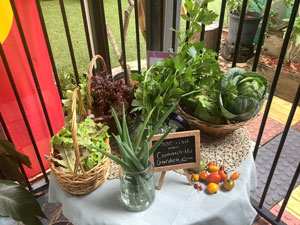Spring is a glorious time to be in the garden and the benefits are more than just beautiful flowers and delicious vegies.
Gardening can be used as an educational tool for children to develop new skills. By involving children in creating and caring for a garden, you could be helping them to develop a sense of responsibility, understanding, cooperation and a love of nature.
Children learn so much from gardening and you can plant the seeds by integrating garden play into your service.
Narelle Dawson, director and teacher at Bribie Island Community Kindergarten, has with and alongside the children, parents and community, established a garden in the service as well as a community garden. She says the benefits of gardening for children are endless.
 Freshly picked produce from Bribie Island Community Kindergarten.
Freshly picked produce from Bribie Island Community Kindergarten.
'It’s a web that reaches out in so many areas and in so many ways,' Narelle said.
'The children are learning about success and failure and we research so we can be more successful next time.
I have seen the children take pride in their achievements and build confidence in engaging with community members who help look after our garden and share our produce.'
Narelle said including garden play into the children’s routine has opened up new worlds for the children by providing opportunities to interact with garden volunteers from across their community. The children ask them questions, engage with them and in turn, they are learning all about different people from diverse backgrounds and cultures. This aligns perfectly with
Quality Area 6—Collaborative partnerships with families and communities.
'We talk about gardening as nourishement for the mind, body and soul and it is in every area of our curriculum.'
Benefits from garden play
Physical skills
Children develop fine and gross motor skills through digging, watering, weeding and planting seeds. They also learn about nutrition and healthy eating from the fruit and vegetables they have grown.
Emotional wellbeing
Gardening and connecting with nature promotes positive wellbeing and may help children regulate emotions and reduce anxiety.
Social skills
Looking after a garden involves responsibility and collaboration. As children work together to prepare for planting, care for plants and share produce with family, they learn to take turns and communicate in meaningful ways. (Element 5.2.1—Collaborative learning)
STEM skills
There are endless opportunities to develop and explore STEM skills and concepts in the garden, for example, identifying different plants, measuring the distance to plant seeds or investigating what plants need to grow, how much water can be carried or how tall and heavy tomato plants can be supported.
Creative thinking
Gardening provides many opportunities to problem-solve, investigate, imagine and create. Children can draw or design the garden beds, make collages from seeds, leaves and flowers, or create their own mini fairy or dinosaur garden.
Environmental understandings
As they garden, children develop connections with and understanding about the environment. They learn about sustainability, using resources wisely, composting, life cycles, growing produce and so much more. (Element 3.2.3—Environmentally responsible)
How to get started
The good news is, it’s easy to get started and you don’t need a lot of space.
Narelle suggests you begin with research.
'Find out what is already growing in your community,' she said.
Use pots or buckets and grow herbs, flowers or cherry tomatoes. You can also grow beans or sprouts in egg cartons or small containers.
If you have space and time, you can build some raised garden beds, include a compost or worm farm, or maybe start a community garden. Don’t forget a ‘dig and play’ area where children can play in the dirt and not undo all the effort that has gone into creating the garden.
It’s great to include a range of sensory plants with different scents, textures, tastes and colour. Also consider what will grow well in your local area and at different times of the year.
Above all, make it a safe space. Supervise children at all times, apply sunscreen and wear a hat, use suitable tools, never use chemicals, look out for spiders and other insects that may be harmful and wash hands after being in the garden.
Enjoy watching your children (and garden) grow!
Further reading
Linking garden play to the Early Years Learning Framework (ACECQA) (PDF, 431KB)
Quality Area 3—Physical environment (ACECQA)
Quality Area 5—Relationships with children (ACECQA)
Quality Area 6—Collaborative partnerships with families and communities (ACECQA)
Benefits of gardening with young children
What to plant and tips for setting up your garden
Cultivating STEM skills in the garden
Different gardening activities for children